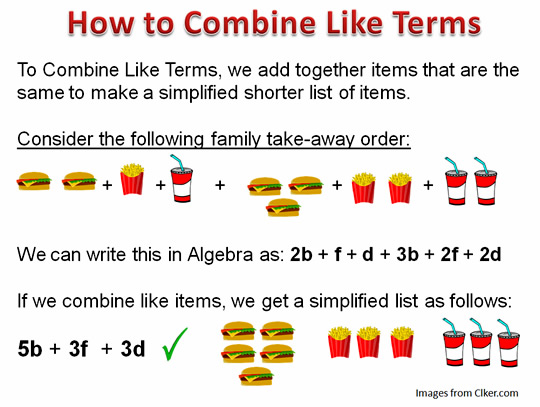CCSS.MATH.CONTENT.6.EE.A.3 Apply the properties of operations to generate equivalent expressions. For example, apply the distributive property to the expression 3 (2 + x) to produce the equivalent expression 6 + 3x; apply the distributive property to the expression 24x + 18y to produce the equivalent expression 6 (4x + 3y); apply properties of operations to y + y + y to produce the equivalent expression 3y.
CCSS.MATH.CONTENT.6.EE.A.4 Identify when two expressions are equivalent (i.e., when the two expressions name the same number regardless of which value is substituted into them). For example, the expressions y + y + y and 3y are equivalent because they name the same number regardless of which number y stands for.
How can combining like terms make sense and be fun?
How can we understand the properties to the best of our abilities?
Well, lets try our best!
Combining like terms...
"Like terms" are terms whose variables (and their exponents such as the 2 in x2) are the same. The coefficients (the numbers we multiply by, such as "5" in 5x) can be different.
Example: 17x x -2x -23x
Are all like terms because the variables are all x
The best way the students can comprehend like terms is in relation to TWO real life examples! We understand there are many more; however, the two examples below seem to stick best with the students.
EXAMPLE 1

Students can use the lunch tray to discuss like terms and combining them.
Imagine, your peaches are the variable y³, the corn is the variable y, milk is the variable g, mashed potatoes are the variable x, your roll is variable 2x , and the chicken nuggets are cx.

Imagine, your peaches are the variable y³, the corn is the variable y, milk is the variable g, mashed potatoes are the variable x, your roll is variable 2x , and the chicken nuggets are cx.
"Would you pour your peaches in your milk? in your mashed potatoes?"
"Would you dip you chicken nuggets in your peaches? in your milk?"
Every response was GROSS or EW!
So, the moral of the example: if we think it is gross or wouldn't want to mix those foods, then we should not combine (or "mix") those terms that are not the same.
EXAMPLE 2
Your family has decided to eat out for the night. Taco Bell for a few members and McDonalds for a few others.

When we get to the microphone to place our order, wouldn't it be easier to have our order in the simplest way to not confuse or miss any items while placing our order? The students realized that their parents already "simplify" (combine) their orders to make it easiest when they are going to get the food.
Here are a few samples of how the students practiced combining like terms (as well as during the warm-up, practice problems, quizzes/assessments)












































